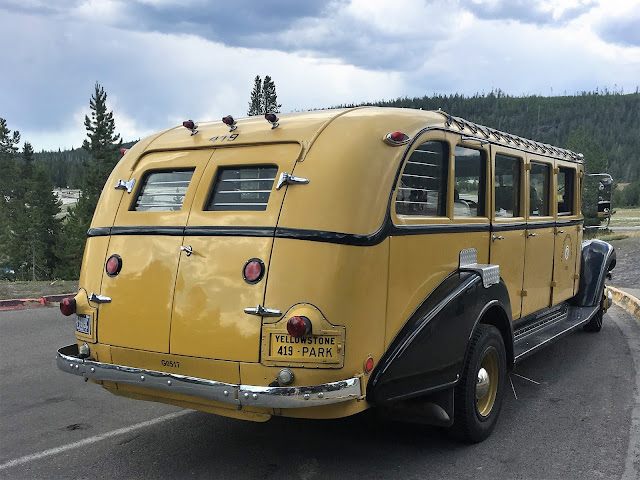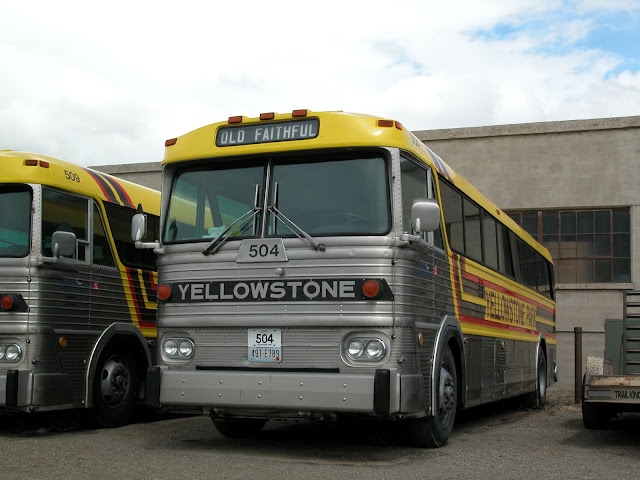Somewhere, as a kid....National Geographic back issue? Old stuff at my grandmother's?....I had seen and fallen in love with the old yellow buses that roamed Yellowstone National Park. I remember wanting to ride in one if I ever got to Yellowstone. And I was certain as time went on that they'd be long gone.
So when this summer rolled around, Mrs. TireKicker and I took a two-week, 3300-mile roadtrip that included Yellowstone and they were still on the road, I could barely contain my excitement.
 |
| 1937 White Yellowstone National Park Motor Coach. |
And when I told our driver/tour guide Tom how much I'd always wanted to ride in one of these, he told me I could ride up front.
 |
| Driver/tour guide Tom. |
 |
| 1920s-era Yellowstone bus. |
Replacements were hurriedly ordered and the new ones arrived just in time for that year's tourist season. Fast-forward eleven years and those machines were getting tired. Plus, there had been enormous advances in motorized transportation between 1925 and 1936. In short, it was time for new buses.
GeyserBob.org (a great Yellowstone history site) tells how Yellowstone settled on the 1936 White Model 706, buying 98 of them between 1936 and 1939. It also details how, as post-war automobile travel grew, the 30s-era Whites themselves became obsolete.
 |
| 1950s-era Ford Yellowstone National Park bus. |
According to the National Park Service website, the 30s Whites were gradually retired from service until, by the late 70s, none were left, apart from one original in the NPS museum.
 |
| 1975 MCI Yellowstone bus. |
The original Whites? They were in private hands. Some having sold for as little as $750. Some were well cared-for, some not:
 |
| 1930s-era White Yellowstone National Park Motor Coach returning to dust. |
 |
| 1937 White Model 706 at Mecum Auctions, Monterey, California 2016. |
According to GeyserBob.org, the Skagway Street Car Company in Alaska had managed to buy eight running survivors from various collectors and had them in service for tours. In 2001, Skagway wanted to modernize its fleet and asked Xanterra Parks and Resorts, which has the concession for hotels and transportation at Yellowstone, if there was any interest in buying them back. There was, they did and....that's not the end of the story.
 |
| 1937 White Yellowstone National Park Motor Coach. |
Most of the reasons these machines got retired in the first place (lack of power, parts availability) still applied. So Xanterra set about getting them ready for modern duty. GeyserBob.org reports the bodies were taken off their 1930s chassis and put atop Ford E-450 chassis, giving them a contemporary powertrain.
 |
| Instrument panel of refurbished 1937 White Yellowstone National Park Motor Coach. |
The gauges, steering wheel, pedals and gear shift are all stock Ford E-450. Think the last rental car shuttle bus you rode in. Heat was added for comfort, power windows for the front doors and a modern two-way radio and public address system.
 |
| Wooden body under a metal shell. |
The bodies are made of wood, with a painted metal shell attached. Even good ones are at some point in the decay cycle. That had to be addressed. In short, according to GeyserBob.org, it cost Xanterra $1.9 million to buy and make those eight buses ready for service in this day and age. They were beautiful, ready for duty....and the purists had a fit. Bus preservationists wanted the coaches restored, not refurbished. Never mind that they would have been useless and unable to meet current safety standards.
 |
| The old and the new. |
Ultimately, common sense won out, and for the past decade, Yellowstone visitors have been able to enjoy the sight of these beautiful old machines on the park's roads. So what if the two vehicles in the picture above have the same chassis, one stretched, one not?
 |
| 1937 White Yellowstone National Park Motor Coach on the "Geyser Gazer" tour. |
So about that headline..."Don't Call It A Bus". Why? Well, that comes from driver Tom, who says that there are certain roads in Yellowstone National Park where buses are prohibited. A lot of them, the narrow roads that are a key part of the "Geyser Gazer" tour we took. But if you call it a "motor coach" and not a "bus"...no problem.
I may be a journalist, but I think I'll just let him have that one. Facts and a good story, you understand.

